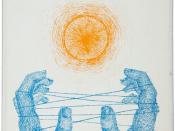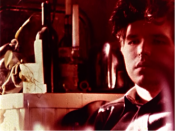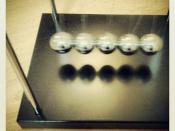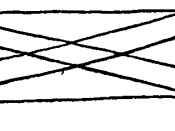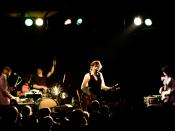Ice-9 is a solid pearlish blue substance, which would kill a person if it came in contact with their mouth. This is one of many intriguing things discussed in the novel Cat's Cradle. Kurt Vonnegut wrote about such a thing in his book Cat's Cradle. The author's worldviews greatly affected the themes presented in this book. Also the settings that Vonnegut painted showed the readers great insight into the characters. Vonnegut's Cat's Cradle attempts to show the audience the evils of nuclear weapons and developing science. His novel shows many impressive themes and wonderfully described settings.
The symbolism in Cat's Cradle is evident throughout the whole book. The predominant symbol is that of ice-9 to modern nuclear weapons. Even though using one or two nuclear bombs might not totally destroy the earth as we know it, it would start a massive world war. A war in which all the superpowers would sling their bombs at each other.
In doing this it would not take them long to completely destroy all chance of life living on earth. Ice-9 occurs in much of the same way. If just a single microscopic crystal of ice-9 were to seep out into a liquid of some form it would be disastrous to all mankind. In the end, it would end up as portrayed in Cat's Cradle the end of life as we know it. While it was evident throughout the whole book what the end would be, it still stirred emotions in the reader's heart to picture the world ending in such a horrific manner.
The bar in Ilium showed great insight into the main character's life. In the book, the bar, the Cape Cod Room, was described as being the beginning and the end of the nightlife in Ilium. Along with being the only place in town to get a drink after hours, it was a favorite hang out for the local whores. This bar sounds like a typical small town bar where everyone knows you by name, and the kind of place where you could sit down and get drunk while talking to a complete stranger for hours on end. The reader got the impression of a dark and dreary place that was constantly remembering the past and never looking toward the future. "But no matter what they call the room, they never change the fugging light fixtures. Never changed the fugging people who come in or the fugging town outside, either"(26). In a way it sounded like the whole town of Ilium, not really intending to go anywhere just existing and doing what it was created to do.
The setting of a novel can drastically affect the reader's interpretation of the literary work. How the author chooses to show aesthetics is a vital part of a novel. The author paints a wonderful picture of the research laboratory in Ilium. The picture that he chose was one of dreariness and superficialness. The research laboratory was part of the General Forge and Foundry Company. Every morning thirty thousand people commuted to and from the company. Inside the research laboratory you find out about all the people working tiressly behind the scenes. For example, hundreds of girls sit around all day at a typewriter doing nothing but listening to some scientist talk about stuff that they don't know about, all while having to type everything he says to paper. "All year long, she said, the girls of the Girl Pool listened to the faceless voices of scientists on dictaphone records-records brought in by the mail girls"(34). This is a good example of how we as humans can sometimes be. We sit around and listen to what is told to us and just take it for granted. It never occurs to us that we should maybe question it or find out if what we are hearing is worth a crap.
Another example of how the setting helps paint a picture in the reader's mind is at the cemetery in Ilium. "Sleet was coming down, acid and gray"(48). It is sleeting, which gives the reader a sense of sadness and depression. When the main character John, walks up to one of the grave stones he has to scrape away the sleet to be able to make out the name on the stone monolith. The whole scene gave the reader a sense of sadness about the situation. It would have been completely different had the main character gone to the cemetery on a nice sunny day. It would have given the setting a much happier and cheerful appearance than a sleeting ice covered cemetery.
Cat's Cradle had a strong reoccurring theme that was presented in many forms throughout the book. The main theme in Cat's Cradle is that in the end everyone looses when we develop and use nuclear weapons. The author dropped many hints at this theme throughout the novel. The whole religion of Bokononism is about hope in a hopeless nation. In the Books of Bokonon there are references to the end of the world and what it will be like. "Someday, someday, this crazy world will have to end, And our God will take things back that He to us did lend. And if, on that sad day, you want to scold our God, Why go right ahead and scold Him. He'll just smile and nod"(180). This is an important point in the reader's interpretation of the book. We as humans are always interested in bettering ourselves and getting to the next best thing. We would never stop and think to ourselves that we should just stay where we are at and not always pursue greater things. Modern science is always developing something new and better to replace the stuff we already have. Cat's Cradle was telling the reader if we continue down this path of constantly developing new and bigger weapons. We will eventually end up destroying ourselves in the end. We may not destroy ourselves on purpose by blowing up other countries with bombs. It might be an accident similar to the one in Cat's Cradle. Something as stupid as a massive disease accidentally escaping a laboratory somewhere in the world and wiping out mass numbers of people. The author is trying to tell us to slow down. Sometimes we all need to stop and smell the roses. We as humans are only interested in making new and better stuff to satisfy our wants and desires. We get so caught up in furthering ourselves that we often don't stop and think about what possible side effects could occur because of our actions. Our, what lasting effect this will leave on the environment. Society in general would be very smart to heed Vonnegut's advice. Science is a good thing, and we need to improve ourselves. In doing so we need to always be careful and stop and think about what the side effects are and what the lasting impact on society would be.
The author of Cat's Cradle talks about his views on capital punishment. Vonnegut views on capital punishment come out quite clearly. He believes we should abolish capital punishment altogether. "Only, after they roasted him," Hazel recalled blandly, "they found out he hadn't murdered his son after all"(70). In San Lorenzo the reader finds out that it is one of the best-behaved countries in the whole world. If fact it has the lowest crime rate of any country in the whole world. The only reason that it has the lowest crime rate is that San Lorenzo practices capital punishment. "The hook for stealing, for murder, for arson, for treason, for rape, for being a peeping Tom. Break a law-any damn law at all-and it's the hook"(69). Everyone in San Lorenzo is afraid of the hook. Which is basically just another way of killing people. Except they let them hang there for a few days so everyone in the town gets the point. Vonnegut implies to the readers that this way of executing people is barbaric. He talks about one of the characters in his book seeing an example of the hook in a museum. Vonnegut drastically affected the reader's view of the government of San Lorenzo. Now the reader sees that the government is nothing more that just another strict dictatorship. The only way they can rule is by instilling great fear in the citizens of San Lorenzo. Rule by fear is not an effective way of ruling a county. Citizens of dictatorships that are forced to like the government or die really aren't the most loyal people. If a chance came along for them to rebel or defect to another country there is a strong possibility that they would do that. If the citizens of a county just fear a government they really aren't supporting the government because there is no reason for them to. People in a dictatorship shouldn't support the government, if the government hasn't done anything to help them out. As is the case in San Lorenzo, except for a few wealthy individuals everyone is poor and lives in poverty. This is not an example of a healthy country.
A major part of Cat's Cradle is the made up religion of Bokononism. This religion is founded by a man named Bokonon. Bokonon as he is potraid in Cat's Cradle is somewhat a mystical man. Vonnecut included this made up religion in his book to show that all religions are founded on lies and treason. "So I said goodbye to government, And I gave my reason: That a really good religion Is a form of treason"(118). According to Vonnegut all religions are essentially useless. If what he says is true than I guess there isn't a Heaven or Hell and we are all just here by random chance. All of this had a large impact on how the reader viewed the book. I felt a great deal of sympathy toward the people of San Lorenzo. They were practicing a bunch of made up lies created by some whacko. On the other hand at least they had something to believe in and to pull them together. Without religion of some sort society would crumble. People need something to believe in. They need to know that they aren't here by a random chance or some freak accident. People need some thing to gather around that tells them that there is a meaning to there existence.
The author of Cat's Cradle had many reasons behind writing this literary masterpiece. One being to announce to the world his disapproval of nuclear weapons. Another would be about religion, and how he feels that all good religions are based on lies in their beginnings. People reading Cat's Cradle who have been affected by a weapon of mass destruction or some other form of science will have a strong connection to the book. They will better understand how it feels to lose someone close to you because of a stupid weapon some scientist made.
Kurt Vonnegut's novel Cat's Cradle gives viewers an opportunity to feel what it would be like to lose someone to a senseless disaster. The theme and setting of Cat's Cradle greatly affect the reader's interpretation of the novel. If everyone in the world read this book the world would stop and think about why they are developing all of these harmful weapons in such mass quantity. Hopefully if all the governments of the world read this book, they would see what they are inevitably doing. Which is bringing us all closer to the end of the world.

